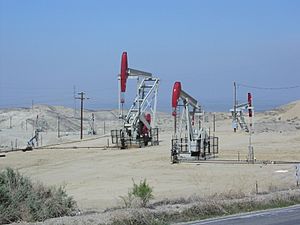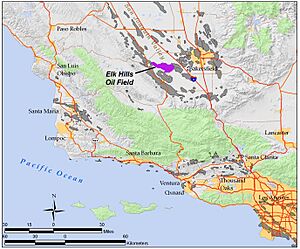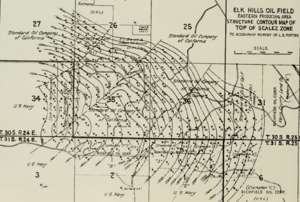Elk Hills Oil Field facts for kids


The Elk Hills Oil Field is a very large oil field located in western Kern County, California. It sits in the Elk Hills area of the San Joaquin Valley, about 20 miles (32 km) west of Bakersfield. This field was first discovered in 1911.
It has produced nearly 1.5 billion barrels of oil and a total of 2.2 billion barrels of oil equivalent (which includes natural gas and other liquids) by the end of 2023. This makes it the fifth-largest oil field in California and the seventh-most productive in the entire United States.
As of late 2023, the Elk Hills Oil Field still holds about 115 million barrels of oil in reserve. It has 2,387 active wells that are still producing oil. It's also the biggest natural gas-producing oil field in California, having produced over 4 trillion cubic feet of gas since it was found. It still has over 700 billion cubic feet of gas left. The main company operating the field is California Resources Corporation.
Where is the Elk Hills Oil Field?
The oil field is located beneath the Elk Hills, which are a series of low hills that stretch from west to east. The highest point of these hills is about 1,551 feet (473 meters) high. To the north, east, and southeast, you'll find large farms in the San Joaquin Valley. To the southwest is the Buena Vista Valley.
Across that valley is the town of Taft, and a huge oil field called the Midway-Sunset Oil Field, which is the biggest in California. West of the Elk Hills is the large McKittrick Oil Field, and to the northwest is the even bigger Cymric Oil Field. Even though the Elk Hills is just one of many oil fields in this area, it stands out because its borders match the shape of the hills it's named after.
A road called Skyline Road runs along the top of the hills, following the length of the oil field. This road is not open to the public. Another road, Elk Hills Road, crosses it about halfway along its length. This road connects Taft to the south with Buttonwillow to the north. The oil field covers about 33 square miles (85 square kilometers).
What is the Geology of Elk Hills?
The Elk Hills Oil Field has a very complex stratigraphy, which means the layers of rock underground are quite complicated. Many other oil fields nearby have simpler structures with just one large oil pool. But at Elk Hills, scientists have found 13 different oil pools. These pools are located in rock layers that range in age from Oligocene to Pleistocene periods.
The shallowest oil pool was found about 1,120 feet (341 meters) below the surface in a rock layer called the Tulare. The deepest pool, called the Agua Pool, is about 9,500 feet (2,896 meters) deep in the Temblor and was only discovered in 1977.
Unique Plants of Elk Hills
The oil neststraw (Stylocline citroleum) is a rare flowering plant that grows only in the Elk Hills area. It was given its name because it is found specifically in this oil field region. This plant is endemic, meaning it naturally lives only in this one specific place in the world.



